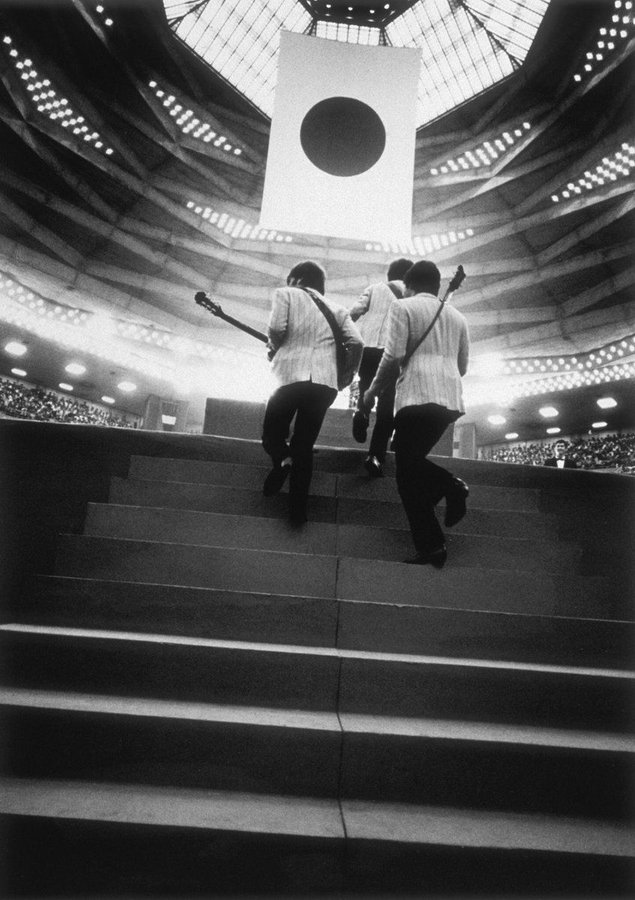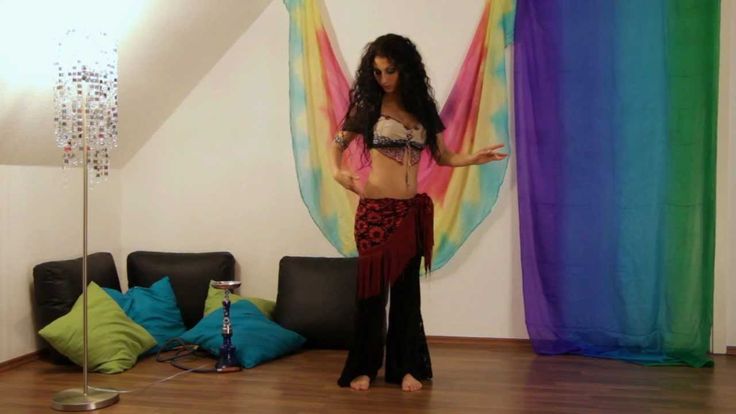How to dance international rumba
Differences between American Style Rumba & International Style Rumba
Dance Insanityblog
American style (also called “Rhythm”) Rumba is kinda like American football – both are super popular in America and America alone.
The International style Rumba, on the other hand, is more like Soccer, super popular all over the rest of the world, especially in Europe and Asia! So, if the rest of the world don’t want to dance American style Rumba, why would you? I’ll tell you why! Because American style is easier in count and technique. Though I confess: my “more” favorite is the International style. Now, how can you differentiate and dance both styles differently?
Difference #1: Bent Vs Straight Knees
In the American style rumba, every step is taken with a bent knee and then straightened at the same time as the hip action.
In the International style rumba, every step is taken with a straight leg. (knee bends when leg is moving and straightens right before you put weight onto the leg)
Difference #2: Box Vs Forward-Back Basic
For American Style Basic Box Step, you make a box with your footwork.
Leader footwork: Forward left, Side right, Close left to right. Back on right, Side left, Close right to left.
Follower footwork: Back right, Side left, Close right to left. Forward left, Side right, Close left to right.
With International Rumba Basic, it’s a forward and back basic (no closing step):
Leader footwork: Forward left, Replace right, Side left. Back on right, Replace left, Side right.
Follower footwork: Back right, Replace left, Side right. Forward left, Replace right, Side left.
Difference #3: Start on Count of 1 Vs 2
Both styles of Rumba uses a 4/4 time; while the Americans start on 1, the Internationals start on 2! 😉
American Rumba:
The Slow step will start on the count of 1. The dance uses Slow Quick Quick Timing – Slow (1,2) Quick (3) Quick (4).
Each Slow = 2 counts and each quick = 1 count. To make a full box basic: Slow-Quick-Quick, Slow-Quick-Quick.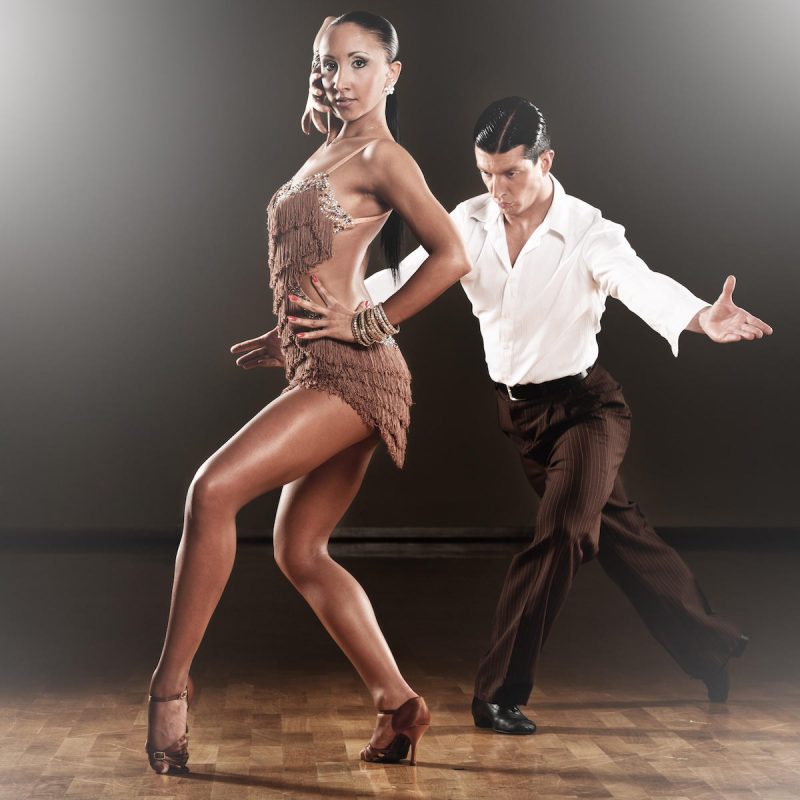
The Slows are often on the counts of 1 and 3.
International Rumba:
Holds the count of 1 and starts on 2. The timing for the basic step is 2, 3, 4 (hold/ nothing on 1). To translate into quick, quick, slow counting, that would be: Quick (2), Quick (3), Slow (4,1).
But note that the SLOW in International style is on often on the count of 4 or 2 (EVEN numbers), whereas in american rhythm, the SLOW is on the count of 1 or 3 (ODD Numbers).
A last word about American Style Rumba Vs International Rumba:I will leave you now, with a sampling of how American style is danced versus International style. Leave me a comment and let me know which one appeals to you more and why!
TAGS: american rumba dance drills technique
5 Common Mistakes In International Rumba AND How To Fix Them
Dance InsanityRumba
Let’s face it. We dance not just to have fun, but also to look good! Sometimes, knowing what NOT to do, is just as helpful as knowing what TO DO. Below, I’ll show you 5 commonly made mistakes in the International Rumba, and how to fix them. Because…
If you’re going to keep dance, you might as well get better each time you do it!
That’s the Asian in me talking. 🙂 We want results! Even if it’s just some improvements, here and there. Over time, they all add up. So if you are guilty of any of these Mistakes, that’s ok. NOW is the time to fix it. You can do it!
Mistake #1: Lifting Your Feet Off The Floor
Quick Fix #1: Keep your toes in contact with the floor
Imagine your 2 feet with paint brushes as toes, and you will keep those paint brushes on the floor as you dance your steps. Save the “taking feet off the floor technique” for JIVE!
Save the “taking feet off the floor technique” for JIVE!
Mistake #2: Heel Leads
Quick Fix #2: Use Toe, Ball, Heel Technique
So, leave the heel leads to your waltzes, foxtrots etc., and keep them out of your Latin dances (except Paso & a few steps in Samba)! If you keep your toes/ balls of the feet on the floor, this will prevent heel leads.
Mistake #3: Keeping Your Weight In Your Heels
Quick Fix #3: Carry your Weight & Torso over the balls of your feet
Say Goodbye to “Back-weighted” and Hello to “Forward-weighted”. Keep your body weight over the ball of the foot you are standing on.
Bonus: Sometimes, students will ask if that means that you need to keep your heels lifted? That’s not the case! Your foot is still flat on the floor, but you carry your weight over the front of the foot. A good way to check if you are doing this right, is to see if you can lift your heel off the floor easily (like doing a heel raise).
Mistake #4: Falling Back In A Back Rock
Quick Fix #4: Move your leg back first when stepping back
Say this after me: “When I take a back step, I will move my leg first, then my body will follow”. Very good! Now, do what you said.
Mistake #5: Stepping on the Count of 1
Quick Fix #5: Count 1, then step on 2.
International Rumba timing is 2, 3, 4 and hold the 1 count. So, practice counting to a song, and doing the rumba basic. Make sure you count 1, 2, 3, 4, 1 then step on 2.
A final word about International Rumba and ways to improve:
Remember: It’s not practice that makes perfect. It’s practicing the right things, that makes perfect.
Build awareness in what your body is doing, so you can correct the mistakes. Be in the moment and consciously practice each thing, so that you feel what it’s like to do it correctly, and what it’s like to do it incorrectly. If I can do it, so can you!
Also check out:
3 Deadly Mistakes in the Jive Chasse (and how to fix them)TAGS: dance drills technique
Rumba dance
Many people dream of learning how to dance rumba, and age will not be a hindrance to this. The main thing is your desire, so those who, for some reason, could not take up ballroom dancing in childhood, can fulfill their dream in adulthood! Our dance and sports club invites women and men to classes, lessons are provided for couples. Learning rumba from our teachers is an opportunity to spend time not only pleasantly, but also with health benefits.
The main thing is your desire, so those who, for some reason, could not take up ballroom dancing in childhood, can fulfill their dream in adulthood! Our dance and sports club invites women and men to classes, lessons are provided for couples. Learning rumba from our teachers is an opportunity to spend time not only pleasantly, but also with health benefits.
Ballroom and other dances provide not only aesthetic pleasure and self-esteem. This is primarily a sport, with carefully calculated loads and results. In our club you can attend a complex of dance trainings, calculated according to individual programs compiled by professionals.
Benefits of Rumba and Latin American dance classes at our club
Each of our beginner dance programs is developed by experienced trainers. The entire learning process is carried out using special programs, it is possible to choose any convenient visiting schedule. Dance classes will be held without deviations from the planned plan and at a high professional level.
You can contact us for training, whether or not you have any training. But we won't have to relax - the classes are serious and bring good results. Advantages of visiting our TSC:
- Our club is designed for professional training, aimed at teaching adults who do not have dance training.
- Experienced high class trainers.
- You can choose an individual schedule of classes.
In our club we are always glad to see those who want to dance at a professional level.
Rumba is a true dance of freedom, spread all over the world from Cuba. Initially, it did not have any loving background: an incredibly fast rhythm is a feeling of celebration and enjoyment, the main theme is the political system and social order. Due to multicultural transformations and various metamorphoses, today we know rumba as a rather restrained rhythm, where romance reigns in every sound. That is why it was fashionable at all times and remains so to this day. The pulsating rhythm does not age and does not lose its relevance: every year thousands of people join this dance culture and make it a real outlet, completely merging into melodies and harmonies. Having plunged into them once, it is very difficult to remain indifferent!
Having plunged into them once, it is very difficult to remain indifferent!
Nowadays rumba is a story of unconditional love. Moreover, a strong feeling is not always directed exclusively towards a member of the opposite sex. Rumba is love for the world, life and oneself; these are unspoken statements about strength, confidence, sensuality and the desire to fall in love with yourself. Dance is living a whole life: quite bright and emotional, having its own context and unique history and unique character. Often the action develops according to this scenario: the partner lures and tries to seduce the partner by all means in order to reject it at the last moment: an eternal dramatic love story unfolds, where one finds it, and the other loses it forever.
Each movement of the dance is filled with power and sensuality, which literally break out with exciting, but simple and romantic sounds.
It often seems that during the execution of movements, ardent glances are directed not into each other's eyes, but are intended for fate itself. Rumba talks about emotions, tells about experiences and passion; these are original beautiful movements in which flirting is easily seen.
Rumba talks about emotions, tells about experiences and passion; these are original beautiful movements in which flirting is easily seen.
Jazz had a significant influence on its formation: unusual elements, typical for typical jazz compositions, were firmly established in rumba and sparkled with new colors.
Rumba is a special atmosphere of the tropics, these are bright, perfectly honed movements of the hips, arms and body.
Guajira, the oldest folk dance, is the historical basis of Rumba movements. Many of its unique ethnic elements are reflected in modern rumba.
It is wrong to think that rumba is exclusively a dance of love: the erotic character and dramatic melodies produce the strongest aesthetic effect. Initially, it was a wedding composition in which the newly-made spouses expressed feelings for each other and showed their readiness for family life.
As a rule, percussion instruments are used to create accompaniment.
Although the dance is rather slow, technically it is not easy: you can do it very well, having learned to keep balance.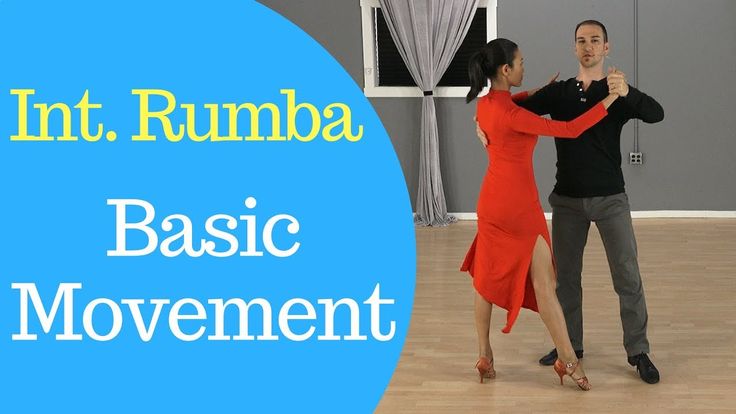 Rumba will allow you to be in tune with your body, feel great about it, become more toned and slender. Dance is a huge range of expressed emotions: from great love and passionate love, absorbing and captivating passions, to icy determination, suffering, hatred. Do not be afraid of shifting accents: it is on them that each composition is built. Dynamic changes and smooth decelerations and accelerations, coupled with long graceful steps, are the real calling card of this dance direction! Starting to comprehend the basics of rumba, you will be recharged with a good mood, plunge into the world of positive and learn to express absolutely all emotions bodily!
Rumba will allow you to be in tune with your body, feel great about it, become more toned and slender. Dance is a huge range of expressed emotions: from great love and passionate love, absorbing and captivating passions, to icy determination, suffering, hatred. Do not be afraid of shifting accents: it is on them that each composition is built. Dynamic changes and smooth decelerations and accelerations, coupled with long graceful steps, are the real calling card of this dance direction! Starting to comprehend the basics of rumba, you will be recharged with a good mood, plunge into the world of positive and learn to express absolutely all emotions bodily!
Rumba (dance for beginners) is a great opportunity to feel the unique atmosphere and enjoy the unsurpassed Cuban flavor. Today, this style of dance enjoys unprecedented popularity: rubma is performed by people of all ages (from teenagers to pensioners). It is fashionable to move to the beat of strong and beautiful melodies in this style.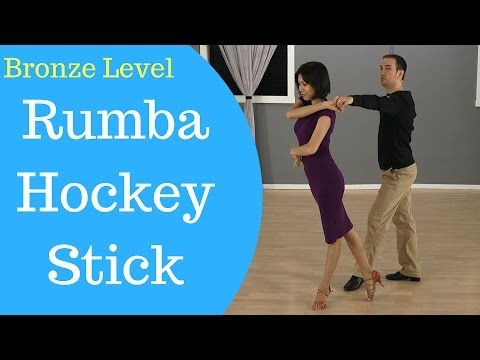 Dance allows you to learn not only to control your own body, but also to feel your partner, to feel his strategy and intentions.
Dance allows you to learn not only to control your own body, but also to feel your partner, to feel his strategy and intentions.
Rumba for beginners is based on basic choreographic elements: a specialist learns the simplest movements with students, conducts practical exercises, telling and showing exactly how to maintain the desired muscle tone, be in concentration, but at the same time feel relaxed and calm (emotionality and passion " connect” at later stages, when a person has the key skills to the right extent: the need to monitor the quality and perfection of each bundle is minimized).
In addition to learning elegant and spectacular elements, rumba dance lessons are aimed at developing sensuality: the choreographer in an accessible way presents information about how, through rumba, you can “splash out” accumulated positive and negative emotions, clear your mind, at least briefly abstract yourself from problems and in general the entire surrounding world.
Each lesson is multifaceted and exciting: a moderate load is given to all muscle groups, joints are worked out, ligaments are warmed up. Do not worry that you can accidentally damage or stretch your muscles - a competent trainer will not allow this: he always focuses on the need to monitor your own well-being and, at the initial moments, perform all the exercises to the best of your ability.
Do not worry that you can accidentally damage or stretch your muscles - a competent trainer will not allow this: he always focuses on the need to monitor your own well-being and, at the initial moments, perform all the exercises to the best of your ability.
After a short time after you seriously begin to comprehend the basics of rumba, you will notice that the muscle corset has become more toned and elastic. An additional pleasant “side effect” is a slim figure and tone of the whole body. Metabolism will also improve and metabolic processes will improve - the internal organs will begin to function more efficiently and smoothly.
By the way, rumba classes affect not only the body, but also the human psyche: training gives a great mood and positive energy for a long time, forms a positive vision of the world and thinking, saturates with positive emotions.
Rumba for beginners teaches how to build communication - it's not just a set of smooth movements, but also gentle, quivering looks, expressive gestures.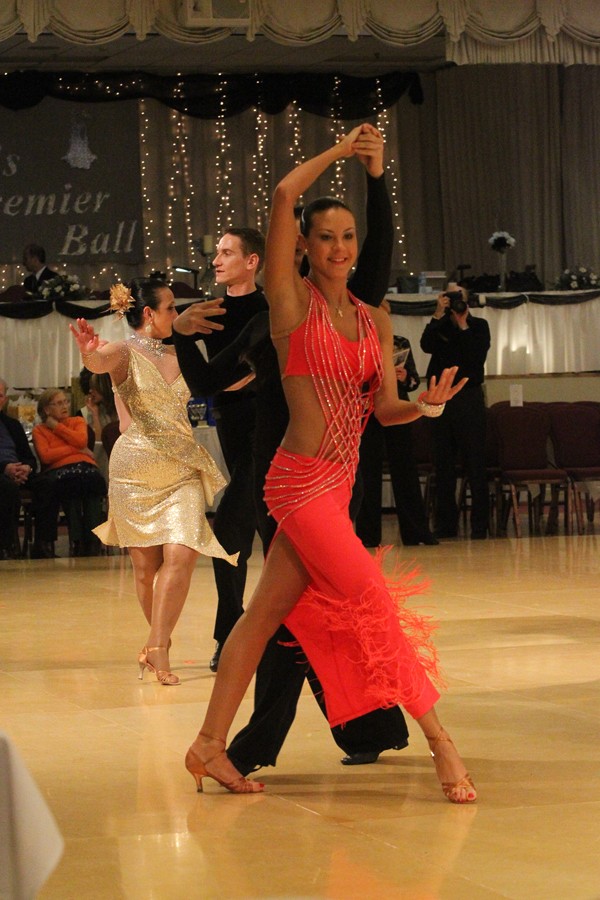 Here intuition develops, the ability to anticipate the actions and intentions of a partner - now you understand the "non-verbal", and this skill is useful in relationships with a loved one, in family, communicating with friends, at work.
Here intuition develops, the ability to anticipate the actions and intentions of a partner - now you understand the "non-verbal", and this skill is useful in relationships with a loved one, in family, communicating with friends, at work.
The choreographic basis is based on several elements, which are further “developed” and supplemented, decorated with small connections and organic turns. The components of the rumba can be played in any order: they fit perfectly with each melody of a moderate tempo.
Don't be afraid to take your first steps! It often happens that they seem incredibly complex and energy-intensive - this is an illusion that dissipates after a couple of visits to the dance club. Our instructors will help and support psychologically, will make every effort to make you feel comfortable! Remember that mastery will definitely come with experience, and experience is the result of practice: constant trials, correction of mistakes and interesting work on yourself!
Latin American couple dance of Cuban origin
Rumba - Latin American couple dance of Cuban origin| HOUSE | MENU | DOKI | SEARCH |
Culture › Dance › Latin American ›
see Recommended literature on dance. Designations and abbreviations
Designations and abbreviations
Latin American couple dance of Cuban origin, part of the international program ballroom dance sport is distinguished by characteristic sensual, love-filled movements. Muses. size 4/4, rate 28-30 t/min. (112-120 bpm).
The name "rumba" may have come from the term "rumboso orquestra", which was the name used in Cuba for musicians who performed dance melodies. The dance originated from Cuban with Spanish roots habanera and African rhythms brought to Cuba at the end of the 19th century. The predecessors of today's rumba were the slow Cuban dances "son" and "danzon", their versions were known in the USA in 1930s
Rumba appeared in Europe thanks to Pierre Lavel, a dance school teacher in London, who developed the standard Cuban rumba based on the folk (Havana) dance. He visited Havana in 1947, and it turned out that the rumba in Cuba is performed with an emphasis on the count of "two", and not on "one", like the American one.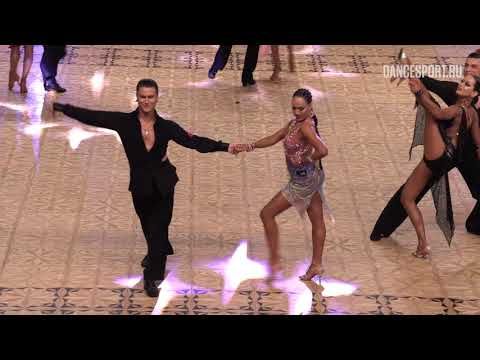 He began to teach this technique in England, performed a lot, and after much debate, in 1955 the rumba was officially recognized and standardized.
He began to teach this technique in England, performed a lot, and after much debate, in 1955 the rumba was officially recognized and standardized.
Thanks to the new variant - only the transfer of weight to the count "one", without the actual step, the dance acquired its famous sensuality and voluptuousness. The first measure in rumba music is the strongest, but only the hips move at this point. Together with the slow tempo of the music and the musical emphasis on the work of the hips, the dance takes on a lyrical and erotic character. Steps are made on the count of 2, 3 and 4.
Square rumba. Dance technique for beginners
Cuban in origin, the rumba has other names depending on the tempo: at a slow pace - bolero, at a fast pace - guaracha. Size: 4/4.
Tempo: 32 measures or 128 beats per minute.
Basic rhythm: fast, fast, slow. Each “fast” corresponds to one beat, and “slow” to two, with emphasis on the first and third beats of the measure. Position: both partners are somewhat distant from each other, the body is straight. The right hand of the partner lies on the left shoulder blade of the partner, the arm is almost extended. The left hand is slightly higher than usual, the left forearm is almost vertical. The shoulders and upper body remain absolutely still during the entire dance. Only a typical movement of the knees causes a slight swaying of the hips. All steps are performed from the ball of the foot.
Position: both partners are somewhat distant from each other, the body is straight. The right hand of the partner lies on the left shoulder blade of the partner, the arm is almost extended. The left hand is slightly higher than usual, the left forearm is almost vertical. The shoulders and upper body remain absolutely still during the entire dance. Only a typical movement of the knees causes a slight swaying of the hips. All steps are performed from the ball of the foot.
1. Progressive move forward (advance step)
Starting position: feet together, facing along the line of dance or facing the wall.
For Partner:
1. Small step with the right foot to the right (quickly).
2. Bring the left foot to the right (quickly).
3. Bring the right leg forward, transferring the weight of the body to it (slowly).
4. Small step left foot to the left (quickly).
5. Put the right foot to the left (quickly).
6. Bring the left leg forward, transferring the weight of the body to it (slowly).
Repeat from point 1.
For Partner:
Performs opposite steps. During the execution of paragraphs 3 and 6, characteristic movements of the knee of the leg appear, on which the center of gravity is not transferred. The knees join without bringing the feet together, which causes a pronounced swaying of the hips. As a reminder, this requires flexibility in the ankles, knees, and hips.
The partner’s progressive move is more often performed back along the line of dance, all steps of steps 1-6 are in the same rhythm (fast, fast, slow), and the partner’s is forward along the line of dance.
Fig. Progressive rumba step
2. Natural square
The movement is performed on the spot. It can be started with both the right and left foot, using it to turn on the spot to the right or left.
For Partner:
Starting position: feet together along the line of dance or facing the wall after a progressive forward move from the left foot (see above).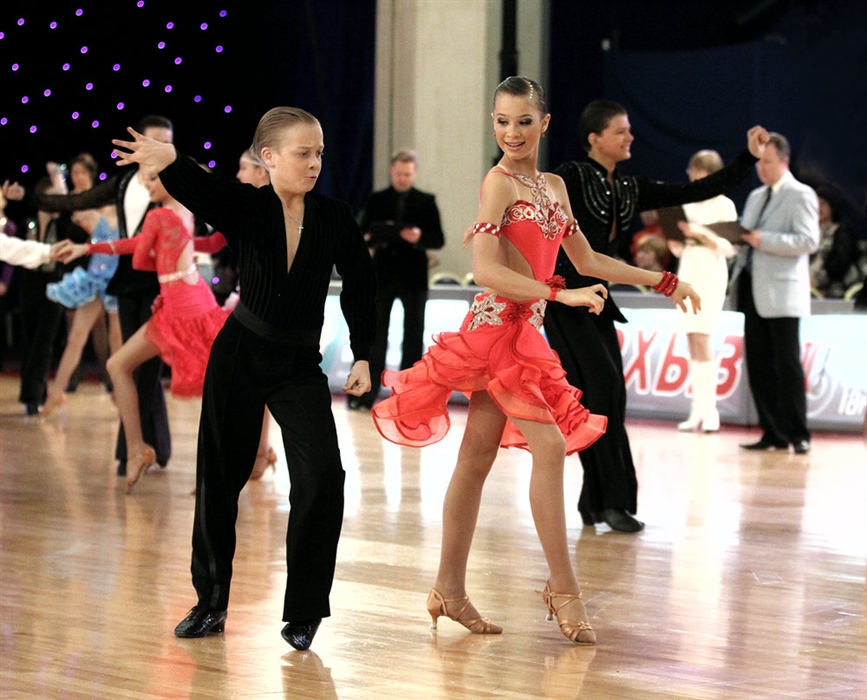 Finishes with a face along the line of dance.
Finishes with a face along the line of dance.
1. Small step with the right foot to the right (quickly).
2. Bring the left foot to the right (quickly).
3. Bring the right leg forward, transferring the weight of the body to it (slowly).
4. A small step with the left foot to the left at the level of the right foot (quickly).
5. Put the right foot to the left (quickly).
6. Bring the left leg back, transferring the weight of the body to it (slowly).
Repeat from point 1.
For Partner:
Performs opposite steps.
This movement can be repeated as many times as necessary. To rotate, increase the angle in the desired direction.
The reverse square is performed in the same way as the natural square described above, but all steps of steps 1-6 are performed from the other foot.
Fig. Natural square
Advanced Rumba Dance Technique
Three styles of rumba are currently popular.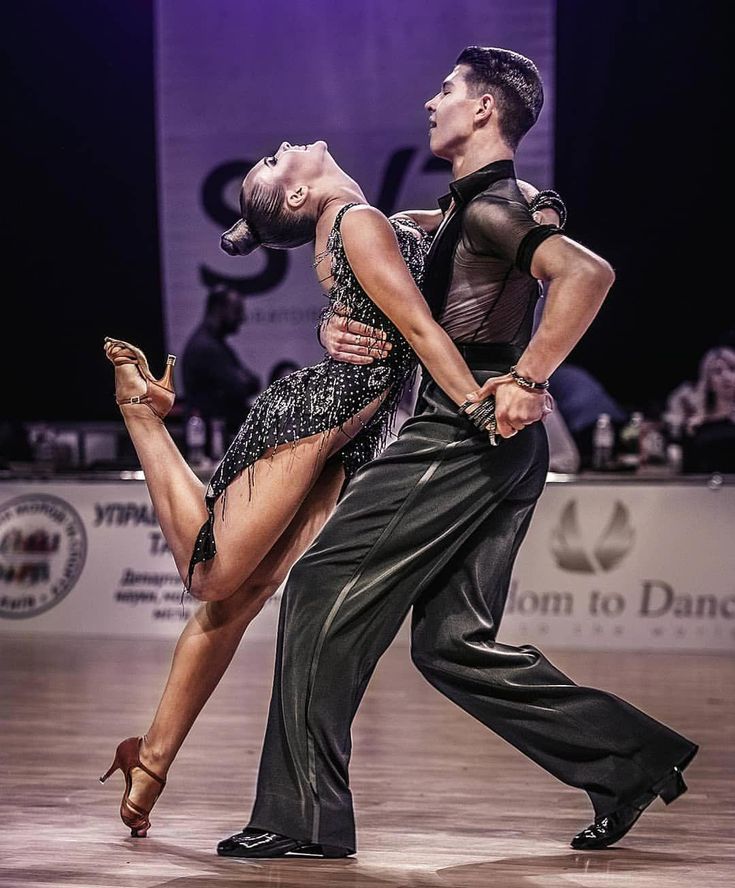
1. Rumba square. The most simply built, with an easily caught rhythm, it is quickly perceived by the dancers.
2. Rumba bolero. Similar to the previous rumba, but played in a slow rhythm. All rumba variations can indeed be played more slowly. Most of the modern melodies, which the uninformed ear perceives as slow, are actually built in the rhythm of the bolero rumba. If you listen carefully to the accompaniment, then determine that it corresponds to the following rhythm: slow, fast, fast, with an emphasis on the second and fourth beats of the bar.
3. Cuban rumba. Standardized by the British, it is the only variant performed in competition. The Cuban rumba requires a good sense of rhythm as well as perseverance to master the fine technical and initially elusive subtleties that result from good balance and excellent coordination of the ankles, knees and hips. Constant training gives the dance an ease that distinguishes a couple dancing in unison. The very rhythm of the Cuban rumba has undergone some changes.
The very rhythm of the Cuban rumba has undergone some changes.
Basic rhythm: fast, fast, slow (count "two", "three", "four", "one").
Position: the partners are at a short distance from each other, the partner puts his right hand on the partner's left shoulder blade, at the same time her left hand lies on the partner's shoulder.
1. Cuban Salute, Twist and Twist (Square Rumba and Rumba Bolero)
This movement can be executed in various ways. The most common is that it is performed after the first part of the square: “one”, “two”, “three” - quickly, quickly, slowly; right, left, right leg for a partner.
The body above the waist should be kept straight, the shoulders should be at the same level at all times. There are no slopes in the rumba. All steps are performed from the ball of the foot to the entire foot. The steps are small. The movement of the hips should be soft, not exaggerated.
For Partner:
Cuban greeting
1. Step left foot forward (quickly).
Step left foot forward (quickly).
2. Step right foot to the side to the right (quickly).
3. Step back with the left foot (slowly).
Screwing
1. Step with the right foot forward towards the partner, but with a turn to the right (quickly).
2. Step left foot forward; continuing to turn to the right, the partner rotates in the hands of the partner (quickly).
3. Step with the right foot forward, rotating in the same way, taking with the left hand the right hand of the partner, “twisted” on the right hand of the partner (slowly).
4. Step left foot forward, turning clockwise; the partner releases the waist of the partner and takes her left hand with the right hand (quickly).
5. Step right foot forward, continuing to turn (quickly).
6. Step left foot forward, continuing to turn and go half a circle (slowly).
7. Step right foot forward, turning in the same direction (quickly).
8. Step left foot forward, continuing to turn (quickly).
Step left foot forward, continuing to turn (quickly).
9. Step right foot forward, ending the turn and going full circle (slowly).
Unrolling
1. Step forward with the left foot, spinning the partner to the right away from you (quickly).
2. Step right foot to the side to the right (quickly).
3. Step back with the left foot (slowly).
Repeat twisting and unwinding as desired.
For Partner:
Cuban greeting
1. Step right foot back (quickly).
2. Step left foot to the side to the left (quickly).
3. Step right foot back (slowly).
The partner takes the partner's left hand with the right hand. The partner performs a greeting: she raises her right hand at eye level and looks to the right, as if sending greetings.
Screwing
1. Step left foot forward (quickly).
2. Step with the right foot to the side, turning to the left against the line of dance (quickly).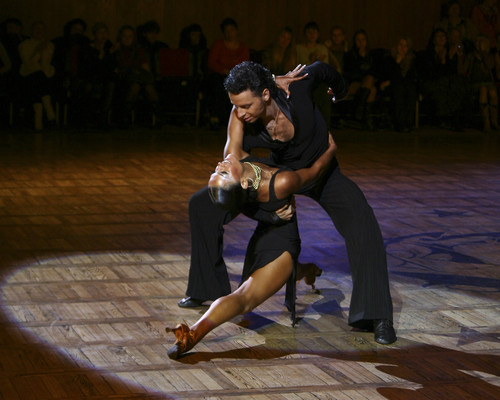
3. Step back with the left foot (slowly).
The partner is next to the partner, "twisted" by his right hand, with which he clasps her waist. In this position, she performs steps like a top:
4. Step right foot back, turning clockwise in place (quickly).
5. Step left foot back, continuing to turn (quickly).
6. Step right foot back, continuing to turn and go half a circle (slowly).
7. Step left foot back, turning in the same direction (quickly).
8. Step right foot back, continuing to turn (quickly).
9. Step back with the left foot, completing the turn and going full circle (slowly).
Unrolling
1. Step with the right foot to the side with a turn to the right from the partner (quickly).
2. Step back with the left foot, facing the partner (quickly).
3. Step right foot back (slowly).
Repeat twisting and unwinding as desired.
Fig. Cuban greeting. Pa partner and partner
Cuban greeting. Pa partner and partner
Note: At the end of this figure, the partner and the lady are in the opposite direction from the original; however, depending on the length of the steps performed on the turns, it may vary. Starting a figure, one should take into account the direction of the body in relation to the audience.
2. Top (Square rumba and bolero rumba)
Here we present a series of cute movements that require little space to perform. This series is very effective and like partners, even inexperienced. Consider a simple but very beautiful spinning top. It is performed in the promenade position, for example, after the Brazilian push (see below). Promenade position for three beats of a measure: for “one”, “two” - the main movement, for “three” - the partner puts his leg forward diagonally towards the partner (he wraps his arm around her waist) to be in the promenade position diagonally to the center.
The partner can then move back to the top, performing the steps of the Cuban march, i.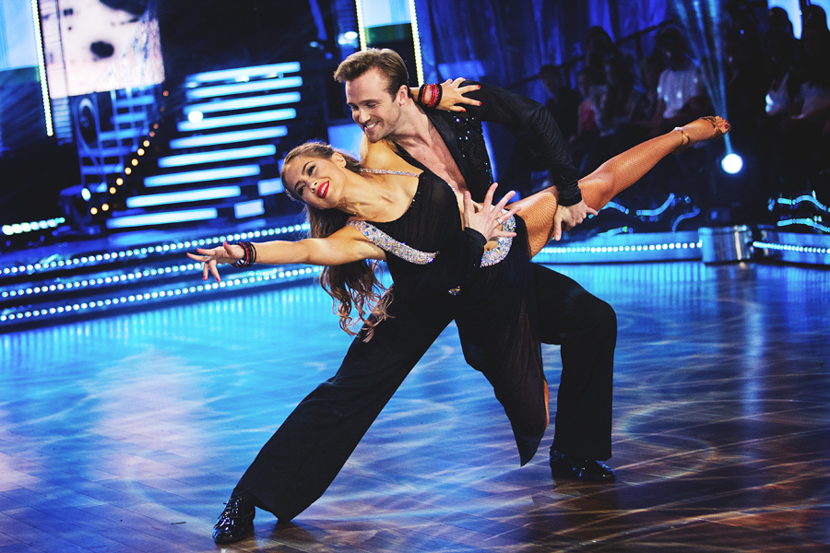 e. stepping back in the rhythm of the rumba (fast, fast, slow) - two steps are the same, and the third is extended.
e. stepping back in the rhythm of the rumba (fast, fast, slow) - two steps are the same, and the third is extended.
For Partner:
1. Step left foot back behind the right foot with a turn to the left (quickly).
2. Step right foot to the side with a turn to the left (quickly).
3. Step with the left foot back with a turn to the left, as in point 1 - extended step (slowly).
4. Step with the right foot to the side with a turn to the left, as in point 2 (quickly).
5. Step left foot back with a turn to the left, as in point 1 (quickly).
6. Step with the right foot to the side, as in point 2 - extended step (slowly).
7. 8. 9. Correspond to 1, 2, 3, but the partner takes his right hand off the partner's waist and stands opposite her, as in the main movement. He can now perform a square starting with the right foot (fast, fast, slow).
For Partner:
Performs opposite steps, following the partner flexibly and in sync. The movement of the hips in the variation of the "top" is absent.
The movement of the hips in the variation of the "top" is absent.
Fig. Top. Pa partner: 1-9 - rotational concentric movements of the feet and return to the starting position
3. Brazilian kick (Square rumba and bolero rumba)
This fun variation breaks the basic rumba rhythm. It is danced to the rhythm of fast, fast, slow, "and" (or "one", "two", "three", "four", "and").
On "and" - a pair in the promenade position (from opposite legs) makes a push, which is performed by a slight sliding of the toe on the floor, as if you need to slightly move some light object.
For Partner:
1. Step with the right foot to the side to the right (count "times").
2. Pull the left leg to the right (two count).
3. Step with the right foot diagonally forward and to the right towards the partner, hug her waist with the right hand; couple in position promenade (count "three", "four").
4. Brazilian left leg push (count "and").
5. Step forward with the left foot, transferring body weight to it; promenade position diagonally to the center (count "times").
6. Cross the right leg behind the left in the same position (two count).
7. Step left foot to the side to the left with a turn diagonally to the wall (count "three", "four").
8. Brazilian push with the right leg (account "and").
Repeat as desired.
To return to the starting position at the moment of pushing with the right foot (p. 8), do not perform it for the last time, but stand in the line of dance, thereby indicating to the partner that she should no longer cross her legs. However, you can allow her to make this push, and the partner at this time will have the opportunity to indicate to her a change of direction, adhering to the line of dance.
For Partner:
During the first three beats of the measure, it becomes promenade.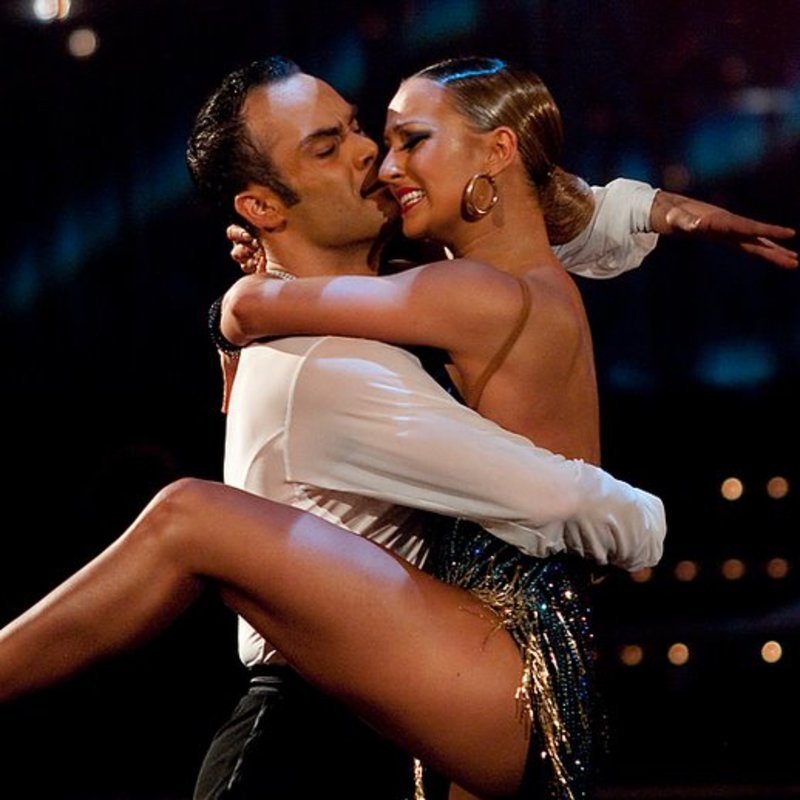
1. Step left foot to the side to the left (count "times").
2. Pull the right leg to the left (two count).
3. Step left foot to the left, slightly towards the partner, who wraps his arm around her waist; partners touch their hips (count "three", "four").
4. Push with the right foot diagonally to the center (count "and").
5. Step forward with the right foot, transferring the weight of the body to it, turning the back diagonally to the wall (count "one").
6. Cross the left leg in front of the right in the same direction (two count).
7. Step right foot to the side to the right with a change of direction, back diagonally to the center (count "three", "four").
8. Push with the left foot diagonally to the wall (count "and").
Continue as desired. If the partner moves to the main movement, the partner performs the opposite steps.
Note: In order to achieve success in this beautiful figure, the pair may, at the time of the kick, make a light and flexible movement of the knee of the skating leg, which makes it more graceful.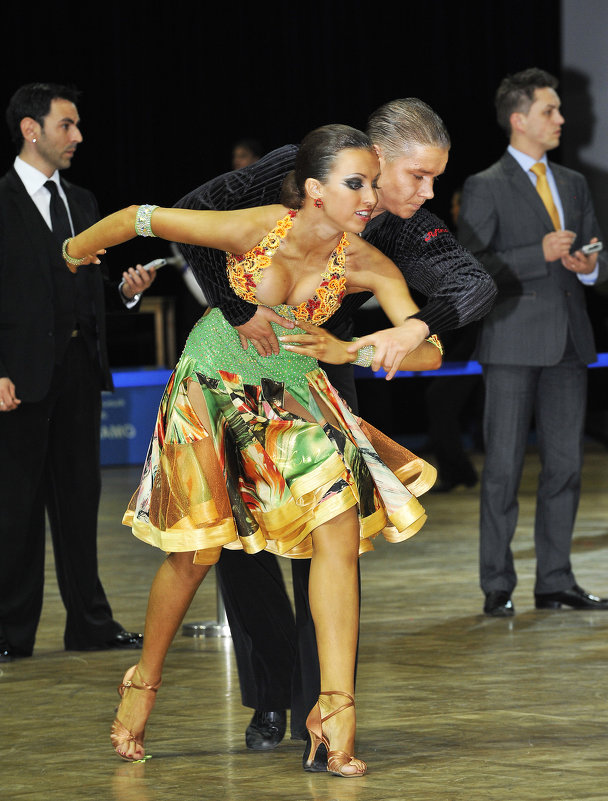 You should not lift your foot off the floor and perform a push with the heel, except when you need to make the movement comical.
You should not lift your foot off the floor and perform a push with the heel, except when you need to make the movement comical.
Fig. Brazilian leg push
4. Main movement (Cuban Rumba)
The movement is very beautiful if performed by flexible dancers who have a good sense of rhythm. However, we still advise debutants and other dancers to perform it, as it helps to elegantly link the figures.
For Partner:
1. A small step forward with the left foot, first on the front of the foot, and then on the whole foot (two count).
2. Transfer the weight of the body to the right leg back without moving from the spot (count "three").
3. Small step with the left foot to the side to the left with support on it - fix (account "four", "times").
4. A small step back with the right foot (two count).
5. Transfer the body weight to the left leg forward (count "three").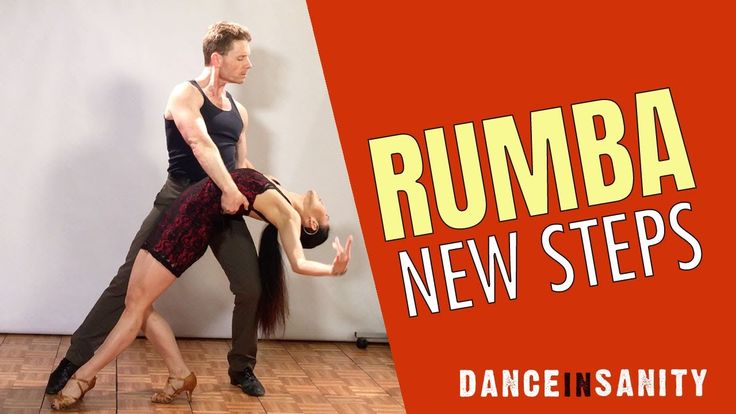
6. A small step with the right foot to the side to the right, relying on it - fix (count "four", "one").
For Partner:
Performs opposite steps: p. 1-3 correspond to p. 4-6 of the partner; p. 4-6 - p. 1-3 of the partner.
Fig. The basic movement of the rumba. Pa partner. The partner performs the opposite steps; 1, 5 - movement in place, where the steps are fixed without shifting the feet
5. Natural Spinning Top (Cuban Rumba)
This 12-measure figure is played with a right turn. It is almost identical to the top of the rumba square, you just need to adapt it to the rhythm of the Cuban rumba.
When performing this figure, the partners are facing each other. The turn to the right is performed clockwise around its axis, there is no advancement.
For Partner:
Performs paragraphs 1-3 of the main movement, but takes the third step to the side and slightly back (counting "two", "three", "four", "times").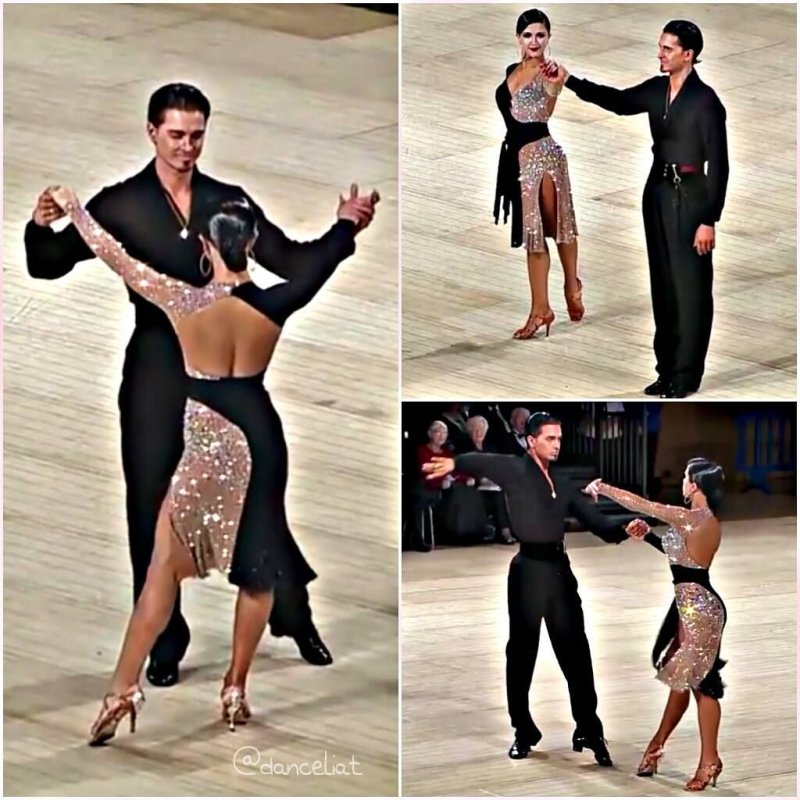
Then continues as follows:
1. Turn to the right, cross the right foot behind the left (toe turned out), place the toe of the right foot at the heel of the left (two count).
2. Continuing to turn to the right, take a step with the left foot to the side to the left and slightly forward (toe turned inward) - count "three".
3. Repeat step 1 (count "four", "times").
4. Repeat step 2 (count "two").
5. Repeat step 1 (count "three").
6. Repeat step 2 (count "four", "times").
7. Repeat step 1 (count "two").
8. Repeat step 2 (count "three").
9. Put the right foot to the left (count "four", "times").
For Partner:
Performs paragraphs 1-3 of the main movement, but takes the third step to the side and slightly forward (counting “two”, “three”, “four”, “time”). Then he continues as follows: 1. Turn to the right, take a step with your left foot to the side and slightly forward (toe turned inward) - count "two".
Fig. Open position - fan
2. Continuing to turn to the right, make a small turn on the toe of the left foot and cross the right foot in front of the toe of the left; the heel of the right foot is in front of the toe of the left, and the toe of the left is turned outward (count "three"). 3. 4. 5. 6. 7. 8. Repeat step 1 and step 2 alternately (count “four”, “one” - “two”, “three”, “four”, “one” - “two” , "three"). 9. Continuing the turn to the left, step with the left foot to the side to the left (count "four", "times").
6. Fan (Cuban Rumba)
This is a graceful and easy to perform figure, during which the partner must carefully monitor the execution of her movements, and the partner must give a sign at the moment of the removal and return of the partner. The fan stance is a classic rumba and cha-cha stance.
For Partner:
Starts in normal position, ends in open position. The partner is to the left of the partner. The fan is usually preceded by paragraphs 1-3 of the main movement. Then continues as follows:
The fan is usually preceded by paragraphs 1-3 of the main movement. Then continues as follows:
1. Step with the right foot back, leading the lady, who takes a step forward towards the partner (two count).
2. Transfer the weight of the body to the left leg forward and lead the partner, who turns to the left; release the right hand (count "three").
3. Small step with the right foot to the right, continuing to lead partner with the left hand, lowering it to the level of the partner's waist (count "four", "times").
In the “fan” position, the partner is to the left of the partner at a distance of almost outstretched left arm; her body is at right angles to her partner's body and about 15 cm in front.
For Partner:
1. Step forward with the left foot, first on the ball of the foot, then on the whole foot; moving in line with a partner (two count).
2. Turning to the left, take a step with the right foot back and slightly to the right; Release your left hand (count "three").
3. Continuing to turn to the left, take a step back with your left foot; at the end of the movement, loosen the heel of the right foot (count "four", "times").
Note: There are other, more complex ways to get into the fan position. Described - the most applicable. Usually the "fan" movement is associated with other variations - the aleman, or hockey stick (see below).
Fig. Fan. pa partner and partner
7. Alemana (Cuban Rumba)
This figure is performed after the fan, with which it goes well.
For Partner:
1. Step forward with the left foot, leading the partner, who puts her right foot to her left (two count).
2. Transfer body weight back to the right leg, leading the partner forward (count "three").
3. Put the left foot to the right, leading the partner forward with the left hand and starting to turn her to the right (count "four", "one").
4. Step with the right foot back, leading the lady who continues to rotate to the right under the partner's raised left arm (two count).
Step with the right foot back, leading the lady who continues to rotate to the right under the partner's raised left arm (two count).
5. Transfer body weight to the left leg (in place), leading the partner, who continues to rotate to the right (count "three").
6. Bring the right foot to the left, allowing the partner to complete the rotation to the right, and take the newly closed position (count "four", "one").
Partner has no turn in this piece.
Fig. Alemana. pa partner
Note: It should be noted that the steps of the alemana are the same as in the main movement, so special attention should be paid to the “play” of the hands.
For Partner:
1. Put the right foot to the left in the "fan" position (count "two").
2. Step forward with the left foot towards the partner (count "three").
3. Step with the right foot forward facing the partner, starting in front of him to turn to the right under the raised right hand (count "four", "one").
4. Step left foot forward, turning to the right (two count).
5. Step right foot forward, continuing to turn (count "three").
6. Step with the left foot forward and to the side, ending with the turn facing the partner (count "four", "one").
Links and variations
A. Square rumba and bolero rumba
1. Consisting of 8 bars:
Advance step - square - advance step - square with half turn to the right. Repeat in a new direction.
Square - first three steps with advance - Cuban salute - twist - unwind - 3 steps back. Repeat.
Square - opening in the promenade position - spinning top - square. Repeat.
2. Consisting of 16 measures:
Square - Promenade opening - Brazilian leg kick (2 times) - Finish on the right in Promenade position - spinning top - Finish with the main movement and Cuban salute - twist - unwind (optional) - 3 steps back.



